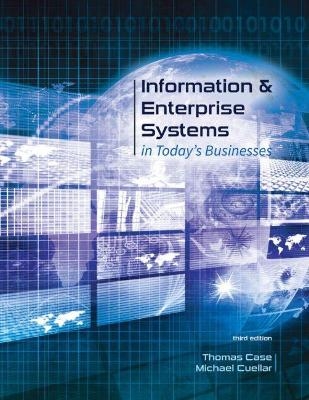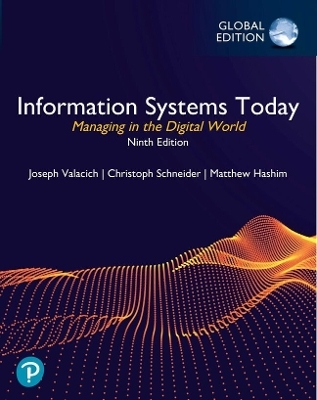
Information and Enterprise Systems in Today's Businesses
Kendall/Hunt Publishing Co ,U.S.
978-1-7924-2119-8 (ISBN)
- Titel nicht im Sortiment
- Artikel merken
Information and Enterprise Systems in Today’s Businesses establishes a strong focus on enterprise systems, their roles in supporting and integrating business processes, as well as the challenges and opportunities that come alongside. In addition, this publication discusses disruptive technologies and business analytics within organizations.
Information and Enterprise Systems in Today’s Businesses includes:
Updated SAP ERP tutorials that give students the opportunity to gain firsthand experience with SAP’s newest ERP software.
Numerous end-of-chapter exercises and assignments to illustrate and reinforce concepts presented in the text.
Robust PowerPoint© slides and Test Bank to reflect revised content.
Access to the KHQ mobile study app.
An instructor’s manual.
Chapter 1 The Competitive Landscape: The Technology Focused World of Today’s Businesses
Chapter Objectives
Introduction
Technological Disruption of the Global Business Environment
Technology Driven Globalization
Technological Advancement
Moore’s Law
Nielsen’s Law
Bell’s Law
Metcalfe’s Law
Rising Disruptive Technologies
Artificial Intelligence
Business Analytics
The Internet of Things
Other Disruptive Technologies
Convergence
Technology’s Impact on Global Job Markets
The New Ethical Concerns
About This Course
Summary
Key Terms
Review Questions
References
Chapter 1 Cases
Case Reference
Chapter 2 Business Information Systems: Fostering
Competitiveness in
Today’s Business
Environments
Chapter Objectives
Introduction
Systems Theory
Business Environments
Information Systems
Information
Data and Information
Information Quality
Business Information Systems
BIS Components
BIS Evolution
BIS Goals and Benefits
Efficiency
Effectiveness
Customer Service
Product Creation and Enhancement
Greater Competitiveness
Identifying and Exploiting Business
Opportunities
BIS Challenges and Risks
BIS Success Requires Leveraging a Wide Variety of Knowledge Areas
BIS Technologies Are Evolving at an Extremely Fast and Unpredictable Pace
BIS Terms Can Be Imprecise and Controversial
BIS and Business Alignment Can Be Difficult to Maintain
Lack of Rapport Between BIS Users and Technical Staffs
Investing in IT Is Still Somewhat of a Mystery
No Amount of BIS Security Is Ever Enough
“Hot” IT Talent Is in High Demand and Short Supply
Balancing Personalization and Privacy
Enterprise Information Systems
EIS Components
EIS Evolution
EIS Goals and Benefits
EIS Challenges and Risks
EIS Implementation Projects Can be Lengthy and Expensive
Change Management
Managing Relationships with EIS Vendors and Consultants
BIS and EIS Trends
Summary
Key Terms
Review Questions
Chapter 2 Exercises
Chapter 3 Using Information Systems to Gain and Maintain Competitive Advantage
Chapter Objectives
Introduction
What is Competitive Advantage?
Creating and Sustaining Competitive Advantage
Understanding Industry Structure
Competitive Forces
Supply Chain Forces
An Example Analysis
Selecting a Competitive Strategy
Example of Competitive Strategy in theAutomobile Industry
Impacts of Competitive Strategy on IS
Work Systems
Using IS to Achieving Competitive Advantage
Creating or Improving Products
Enabling Processes
Changing the Structure of the Marketplace
New Technology Adoption Patterns
Disruptive Technologies
Artificial Intelligence
Blockchain
The Internet of Things
5G
Virtual and Augmented Reality
Summary
Key Terms
Review Questions
References
Chapter 3 Cases
Chapter 4 BIS Infrastructure and Competitive
Capability
Chapter Objectives
Introduction
Business Strategy, EA, and BIS Infrastructure
EA Components
Business Architecture
Data/Information Architecture
Application Architecture
Technology Architecture
Security Architecture
Importance of Strategy, Architecture, and Infrastructure
Alignment
BIS Infrastructure
Telecommunications Components
Telecommunications Trends
Hardware Components and Trends
Software Components
System Software
Application Software
COTS Software
Custom Software
Horizontal Market Software
Vertical Market Software
Open-Source Software
Mobile Apps
Software Trends
Data Management Components
Data Management Trends
BIS and Cloud Computing
BIS Security
Layered Security and IA
BIS Infrastructure and Business Strategy
Summary
Key Terms
Review Questions
Chapter 4 Cases
Chapter 4 Appendices
Chapter 5 BIS Acquisition and Implementation
Chapter Objectives
Introduction
Project Management
The Formal Project Management Process
Initiate
Plan
Execute
Monitor and Control
Closure
Benefits of a Formal Project Management Process
Designing the Work System
Developing the Work System
Acquiring the Technology
System Definition
Requirements Analysis
Determining How to Acquire the System
Purchase Off the Shelf and Implement “Vanilla”
Purchase Off the Shelf and Modify
Custom Development
Outsourcing
Determining the Correct Acquisition Approach
Determination Process
Step 1: Gather information
Step 2: Evaluate Acquisition Options
In-House Development
Traditional Waterfall
Approach
Design
Construction
Testing
Agile
Development Methods
Agile Scrum Methodology
Lean and Kanban Software Development
Kanban
Outsourcing
Implementing Systems
Summary
Key Terms
Review Questions
Reference
Chapter 6 Information Systems and Business Processes
Chapter Objectives
Introduction
The Value Chain
Primary Activities
Support Activities
Cost versus Differentiation and the Value Chain
Business Processes
Types of Business Processes
Business Process Decomposition
Cross-Functional Business Processes
Process-Centered Organizations
Business Process Physical, Document, Data, and Information Flows
Information Flows
Instance-Level Information
Process-Level Information
Common Business Processes
Procurement Process
Fulfillment Process
Production Process
Documenting Business Processes
Business Process Flowcharts
Data Flow Diagrams
Business Process Model and Notation BPDs
Flow Objects
Connecting Objects
Swimlanes
Artifacts
Business Process Improvement Programs
Business Process Management
Business Process Reengineering
Six Sigma
Summary
Key Terms
Review Questions
Chapter 6 Exercises
Chapter 7 Enterprise Systems and Integrated Business
Processes
Chapter Objectives
Introduction
Why do Businesses Implement ESs?
ES Examples
CRM Systems
SCM Systems
SRM Systems
ERP Systems
ES Ecosystems
Enterprise Systems Architecture
ERP Architecture and Infrastructure
ERP Three-Tier Architectures
ERP and Client–Server Architectures
ERP Infrastructures
ERP Instances
ERP System Landscapes
ERP and Integrated Business Processes
CRM and ERP Integration
SRM and ERP Integration
SCM and ERP Integration
ERP Selection, Implementation, Upgrade, and Support
ERP Product and Vendor Selection
ERP Vendor Reputation and Situation
ERP Product’s Technical Capabilities
ERP Functionalities and Ease of Use
ERP Product Costs and Return on Investment
Available Training and Support
ERP Vendor Selection Process Phases
ERP Implementation Challenges and Issues
Top Management Commitment
Reengineering Business Processes
Integration with BIS Applications
ERP Consultants
Selecting Employees
Employee Training
ERP Implementation Strategies
ES Management and Governance
Center of Excellence
Enterprise Data Management
Master Data Management
ES and Business Transformation
Summary
Key Terms
Review Questions
Chapter 7 Exercises
Appendix 7.1 Tutorial 0: SAP ERP Navigation
Chapter 8 ERP and Procurement
Chapter Objectives
Introduction
What is the Procurement Process?
Strategic and Operational Procurement
Strategic Procurement
Direct, Indirect, and Capital Goods and Services Procurement
Procurement Process Goals and Measures
Strategic Goals
Operational Procurement Goals
Key Performance Indicators
Procurement Process Actors
Procurement Process Document and Data Flow
Factors/Issues that Complicate the Procurement Process
Supply Chain Scope
Legal Issues
Backorders
Returns Processes
Payment Terms
Procurement Process Automation
E-Procurement
Electronic Data Interchange
Online Marketplaces
Vendor-Managed Inventory
Enterprise Systems
Procurement Process and ERP Systems
Summary
Key Terms
Review Questions
Appendix 8.1 SAP Tutorial 1 - Procurement
Appendix 8.2 Tutorial 1 - You Try It 1 – Procurement Create Vendor
Appendix 8.3 Tutorial 1 - You Try It 2 – Procurement Trading Goods
Chapter 9 ERP and Order Fulfillment
Chapter Objectives
Introduction
Sales and Distribution Process Overview
Fulfillment Strategies
Fulfillment Process Goals and Measures
Fulfillment Process Actors
Fulfillment Process Document and Data Flow
Fulfillment Process Physical Flow
Fulfillment Process Instance and Process-Level Information
Additional Fulfillment Process Documents
Fulfillment Process Automation
CRM Systems
Electronic Data Interchange
Warehouse Automation Systems
ERP Systems
The Fulfillment Process and SAP ERP Systems
Summary
Key Terms
Review Questions
Appendix 9.1 SAP Tutorial 2 - Sales Order Processing
Appendix 9.2 Tutorial 2 - You Try It 1 – Sales Create Customer
Appendix 9.3 Tutorial 2 - You Try It 2 – Sales Fulfill Customer Order
Chapter 10 ERP and the Production Process
Chapter Objectives
Introduction
Production/Manufacturing Strategies
Manufacturing Strategies
Production Process Goals and Measures
Production Process Actors
Production Process Document, Data, and Information Flow
Data Flow
Physical Flow
Instance- and Process-Level Information
Integration with Other Processes
Manufacturing/Production Process Automation
Material Requirements Planning
Manufacturing Resource Planning
ERP Systems
Warehouse Management Systems
Robotics
Additive Manufacturing
Industry 4.0
Manufacturing/Production and SAP ERP
Summary
Key Terms
Review Questions
Appendix 10.1 SAP Tutorial 3 - Production
Appendix 10.2 Tutorial 3 - You Try It 1 – Production Bill of Material
Appendix 10.3 Tutorial 3 - You Try It 2 – Production Semifinished
Chapter 11 Business and the Web: e-Commerce, Media and Collaboration
Chapter Objectives
Introduction
Information Economics
Reach and Richness
Business Impact of Reach-Richness Compromise
Destruction
E-Commerce
Web 1.0
Web 1.0 Business Models
Direct-to-Consumer
Full-Service Provider
Whole of the Enterprise
Navigators
Virtual Community
Content Provider
e-Commerce and ERP Integration
Web 2.0
Characteristics of Web 2.0 Applications
Web 2.0 Application Examples
Social Media and Business
Marketing and Customer Service
Social Networking
Establishing Relationships
Building Capital with Your Connections
Social Media and HRM
Crowdsourcing
Social Media Policy and Ethics
Collaboration
Business and Virtual Teams
Collaboration Technologies
Media Richness and Collaboration
Summary
Key Terms
Review Questions
References
Chapter 11 Exercises
Chapter 12 Business Analytics, Business Intelligence, and Ethical Data Use
Chapter Objectives
Introduction
BA and BI
The BI Process
Relational Databases
Data Quality
Data Presentation and Visualization
Data Governance
Data Warehouses
Extraction and Cleansing
Transformation
Types of Analytic Processes
Descriptive Analytics
Online Analytical Processing
RFM Analysis
Web Analytics
Predictive Analytics
Machine Learning
Regression Analysis
Time Series Analysis
Cluster Analysis
Market Basket Analysis
Decision Trees
Prescriptive Analytics
Big Data
NoSQL Databases
MapReduce
Hadoop
SAP HANA
BI Ethical Issues
Privacy
Ethical Principles for BI
Summary
Key Terms
Review Questions
References
Chapter 12 Assignments
Appendix 12 Tutorial 4 - Business Analytics
| Erscheint lt. Verlag | 30.1.2020 |
|---|---|
| Verlagsort | Iowa |
| Sprache | englisch |
| Themenwelt | Mathematik / Informatik ► Mathematik ► Finanz- / Wirtschaftsmathematik |
| Wirtschaft ► Betriebswirtschaft / Management ► Allgemeines / Lexika | |
| ISBN-10 | 1-7924-2119-2 / 1792421192 |
| ISBN-13 | 978-1-7924-2119-8 / 9781792421198 |
| Zustand | Neuware |
| Haben Sie eine Frage zum Produkt? |
aus dem Bereich


